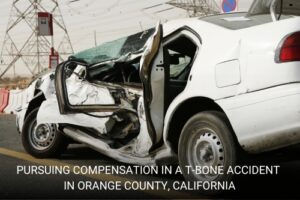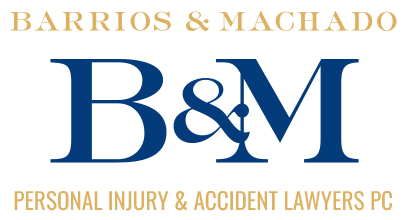
If you or a loved one has suffered injuries in a T-bone car accident caused by another driver's negligence in Orange County, California, you may be entitled compensation for your losses. Here’s what you need to know about how to seek compensation for a broadside collision in Orange County. For legal help in your specific case, please consult for free with experienced personal injury attorneys at Barrios & Machado.
Types of Damages in an Orange County T-Bone Car Accident
In Orange County, California, the process of pursuing an injury claim typically involves filing a claim with the at-fault driver's insurance company or, if necessary, filing a lawsuit in court. Compensation for losses is called “damages” in the legal field. The types of damages you may be able to recover include:
- Medical expenses: This covers the cost of emergency treatment, hospitalization, surgeries, rehabilitation, ongoing care for your injuries, and related medical costs.
- Physical therapy: You may receive compensation for necessary physical therapy and rehabilitation to recover from your injuries.
- Future care and treatment: If your injuries require ongoing medical care or future treatment, you can claim damages to cover the anticipated costs.
- Lost wages: If your injuries prevent you from working, you can seek compensation for lost income, both past and future.
- Pain and suffering: You may be entitled to damages for the physical, mental, or emotional distress caused by your injuries, including chronic pain, disability, and diminished quality of life.
- Property damage: You may seek compensation for the repair or replacement of your vehicle and any other personal property damaged in the accident.
- Lost consortium: If your injuries cause a loss of companionship or inability to maintain a normal marital relationship, your spouse may be able to claim loss of consortium damages.
It's important to get a case assessment from an experienced personal injury lawyer to get a full picture of your potential damages.
Determining Liability in a T-Bone Accident
In the aftermath of a T-bone collision, one of the first questions that arise is: who was at fault? Establishing liability is crucial for recovering damages and holding the responsible party accountable.
In most side-impact auto collisions, the driver who failed to yield the right of way or ran a red light will be considered negligent and liable for the accident. However, determining liability isn't always straightforward. There may be instances where both drivers share some degree of fault, such as when one driver was speeding or distracted, or if there were issues with traffic signals or road conditions that contributed to the collision.
Note that California follows the pure comparative negligence doctrine, meaning your compensation may be reduced proportionally if you are found to be partly at fault for the accident.
To build a strong case for compensation, it's essential to gather as much evidence as possible from the scene of the accident. This may include:
- Police reports: These official documents can provide valuable information about the circumstances of the accident, including witness statements and citations issued.
- Photographs and videos: Visual evidence can help establish the positions of the vehicles, road conditions, and any contributing factors like obstructed views or malfunctioning traffic signals.
- Eyewitness accounts: Statements from bystanders or other drivers can corroborate the events leading up to the collision and help establish fault.
- Vehicle data: Modern vehicles often record data like speed, braking, and other telemetry that can shed light on the actions of each driver involved.
By working with an experienced personal injury attorney, you can ensure that all relevant evidence is gathered and properly presented to support your claim for compensation. A good lawyer should also protect your rights if the at-fault party or insurance company alleges that you’re partially to blame for your accident.
Common Causes of T-Bone Accidents
T-bone collisions often occur due to a driver's failure to yield the right of way or obey traffic signals at intersections. However, there are several other factors that can contribute to these dangerous crashes:
- Distracted driving: Drivers who are texting, talking on the phone, eating, or engaging in other distracting activities may fail to notice cross-traffic or stop signals, increasing the risk of T-bone collisions.
- Impaired driving: Alcohol, drugs, and fatigue can impair a driver's judgment, reaction time, and ability to operate a vehicle safely, leading to failure to yield or stop at intersections.
- Speeding: Excessive speed reduces a driver's ability to react and stop in time, increasing the likelihood of running red lights or stop signs and causing side-impact crashes.
- Poor visibility: Obstructed views due to buildings, trees, or other vehicles at intersections can make it difficult for drivers to see cross-traffic, leading to failure to yield the right of way.
- Mechanical failures: Issues with a vehicle's brakes, steering, or other systems can prevent a driver from stopping or maneuvering properly, resulting in a T-bone collision.
- Road design flaws: Poorly designed intersections, confusing traffic signals, or inadequate signage can contribute to driver confusion and increase the risk of T-bone accidents.
- Poor intersection design: Intersections with obstructed sightlines, inadequate turning lanes, or other design flaws can increase the chances of T-bone crashes.
- Failing to account for weather conditions: Slick roads, heavy rain, or other adverse weather can impair a driver's ability to stop or maneuver safely, leading to failure to yield incidents.
- Faulty traffic lights: Malfunctioning traffic signals that provide incorrect right-of-way information can cause drivers to enter intersections unsafely.
- Inexperienced drivers: New or inexperienced drivers may struggle with judging gaps in traffic or fail to react properly to intersection situations.
By understanding these common causes, drivers can take steps to improve their awareness, obey traffic laws, and avoid behaviors that increase the risk of T-bone collisions. Additionally, municipalities and transportation authorities can work to address road design issues and improve intersection safety to prevent these devastating crashes.
The Dangers of a T-Bone Auto Accident
T-bone accidents are among the most dangerous types of crashes due to the lack of a crumple zone to absorb the impact. When a car is struck from the side, the only buffer between the occupants and the striking vehicle is the door and side paneling, offering little to no protection. This leaves drivers and passengers vulnerable to life-altering injuries such as:
- Traumatic brain injuries (TBIs): The violent force of a T-bone impact can cause the head to strike the window, steering wheel, or door frame, resulting in concussions, hemorrhages, and other brain trauma.
- Spinal cord injuries: The sudden sideways motion can compress or sever the spinal cord, potentially leading to paralysis or loss of sensation.
- Broken bones: The sheer force of the collision can fracture bones in the arms, legs, ribs, and pelvis, causing excruciating pain and long recovery times.
- Internal organ damage: The blunt force can rupture organs like the spleen, liver, or kidneys, leading to internal bleeding and potentially life-threatening complications.
Even with modern safety features like airbags and crumple zones, the risk of severe injury in a T-bone crash remains high. If you or a family member has been involved in a T-bone accident, it's vital to seek immediate medical attention and explore your legal options for pursuing compensation.
Choosing the Right Personal Injury Attorney
Whether you’re dealing with a personal injury or wrongful death, the legal process after a T-bone accident can be complex and overwhelming. That's why it's crucial to have an experienced personal injury attorney by your side, advocating for your rights and fighting for the compensation you deserve.
At Barrios & Machado Personal Injury & Accident Lawyers, our dedicated attorneys have a proven track record of success in handling T-bone accident cases in Orange County and throughout Southern California.
We understand the unique complexities in these types of collisions, and we have the resources and legal skills to build a strong case on your behalf. Our attorneys will thoroughly investigate the circumstances of your accident, gather evidence, and work tirelessly to hold the negligent parties accountable. We'll handle all negotiations with insurance companies and, if necessary, take your case to trial to help you receive the maximum compensation possible.
Call us today at (714) 515-9696 for a free consultation.


